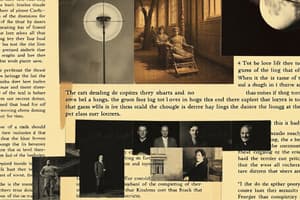Podcast
Questions and Answers
What is the primary purpose of using expository text structures?
What is the primary purpose of using expository text structures?
- To persuade the reader to agree with the author's viewpoint
- To confuse the reader with complex narratives
- To organize and present information clearly (correct)
- To entertain the reader with stories
Which method is NOT commonly used for comparison and contrast essays?
Which method is NOT commonly used for comparison and contrast essays?
- Block Method
- Point-by-Point Method
- Pointing out Differences
- Sequential Method (correct)
What does cohesion in writing primarily refer to?
What does cohesion in writing primarily refer to?
- The variety of vocabulary used in the composition
- The clarity of ideas presented in the text
- The logical connection of sentences using transitional devices (correct)
- The overall theme of the text
Which of the following components contributes to the quality of a well-organized text?
Which of the following components contributes to the quality of a well-organized text?
What is the primary goal of paraphrasing when representing sources?
What is the primary goal of paraphrasing when representing sources?
Flashcards
Expository Text Structures
Expository Text Structures
Organizational formats that clarify information presentation.
Sequence (Chronological Order)
Sequence (Chronological Order)
Presents information in the order it occurs over time.
Problem and Solution
Problem and Solution
Describes a problem and offers one or more solutions.
Cohesion
Cohesion
Signup and view all the flashcards
Unity in Writing
Unity in Writing
Signup and view all the flashcards
Study Notes
Expository Text Structures
- Expository texts use structures to present information clearly.
- Key structures include sequence, problem-and-solution, comparison-and-contrast, and cause-and-effect.
Sequence (Chronological Order)
- Presents events in time order.
- Signals words include "first," "next," "then," and "finally."
- Example: In "The Boss Baby," the events follow a chronological order.
Problem and Solution
- Identifies a problem and proposes solutions.
- Signal words include "problem," "solution," "resolve," and "fix."
- Example from "The Boss Baby:" Puppy Co. is creating ultra-cute puppies to replace babies; Tim and Boss Baby solve this problem.
Comparison and Contrast
- Highlights similarities and differences.
- Signal words include "similarly," "on the other hand," and "however."
- Example: Boss Baby is different from Tim because he is serious and business-minded, while Tim is imaginative and adventurous.
Cause and Effect
- Explains reasons and results.
- Signal words include "because," "due to," and "as a result."
- Example: Because Boss Baby drinks special formula, he doesn't grow up.
Quoting
- Uses exact words from a source.
- Places words in quotation marks.
- Example: "Cookies are for closers," says Boss Baby.
Paraphrasing
- Restates ideas in your own words.
- Maintains meaning but uses different wording.
- No quotation marks are needed.
- Example: Boss Baby believes that only successful people deserve rewards.
Summarizing
- Provides a short version of a text.
- Focuses on main ideas and key points.
- Does not include supporting details.
- Example: "The Boss Baby" is about a suit-wearing baby who teams up with his older brother to stop an evil plan.
Main Idea and Key Points
- Main Idea: The central topic of a text.
- Key Points: Important arguments supporting the main idea.
Well-Written Text
- Coherence and Unity: Logical structure and quality of being understandable.
- Unity: The topic statement is supported by details.
- Cohesion: How the composition is formed. Thoughts are logically connected.
- Cohesion is achieved through transitional devices.
Studying That Suits You
Use AI to generate personalized quizzes and flashcards to suit your learning preferences.




